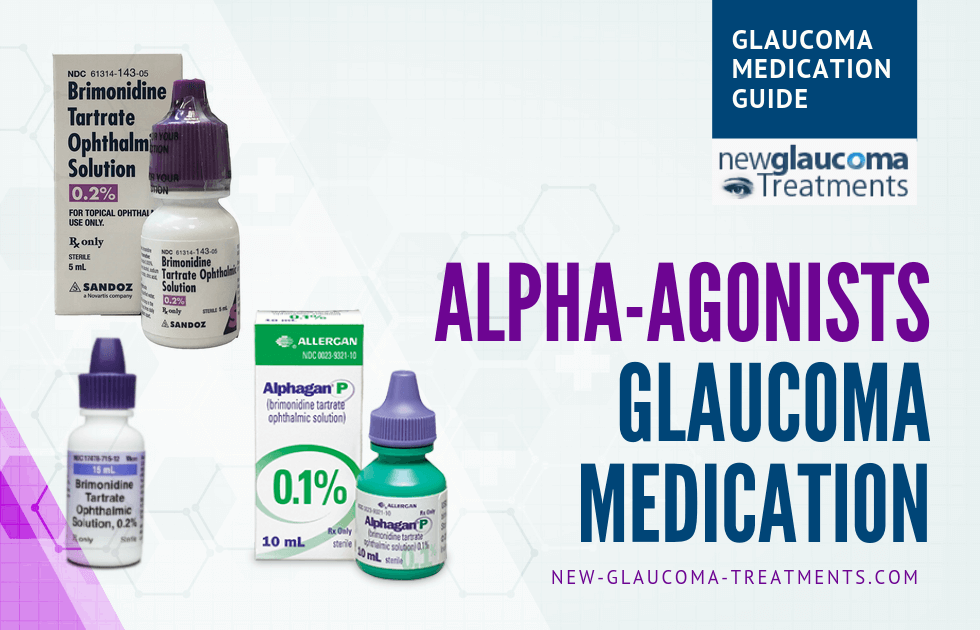A Patient’s Guide to Glaucoma Medications

Alpha-Agonists Medication for Glaucoma
About this class and how it works:
Alpha-agonists have their effect on the ciliary body to reduce production of aqueous fluid. Additionally, like the prostaglandin analogs, alpha-agonists seem to further open the uveoslceral outflow pathway. Finally, there may be an IOP-independent “neuroprotective” benefit[1].
How well does it work:
They work quite well. Studies indicate that alpha-agonists lower the IOP about as much as timolol but are not quite as effective as the prostaglandin analog, latanoprost[2]. They are also effective in preventing post-laser IOP elevation.
When might this class of medications be prescribed?
The most commonly prescribed alpha-agonist, brimonidine, is generally considered a “second line” agent, meaning that it is rarely the first glaucoma medication that will be prescribed for someone with glaucoma. However, there is evidence that brimonidine may be preferred over timolol in those with normal tension glaucoma[3].
How it is Supplied:
In multi-use bottles with purple caps.
Common brands and generics:
- Brand Name: Alphagan-P 0.1%
- Generics brimonidine 0.2% or 0.15%
Note about Preservative-Free options:
Most prescription eye drops have a preservative which keeps bacteria from growing in the bottle. However, the most commonly used preservative, Benzalkonium chloride (BAK), can worsen dry eye and may even be toxic to the trabecular meshwork over time. Given that the trabecular meshwork is already not functioning well in most forms of glaucoma, I generally prefer to prescribe preservative-free versions of glaucoma eye drops when available and affordable.
The branded version of brimonidine (Alphagan-P) is not preserved with BAK. Instead, it is preserved with PURITE® 0.005% which appears to be less toxic to the eye than is BAK.
Available Fixed Combinations:
Brimonidine is available in three fixed combinations in the USA:
- Combigan (brimonidine + timolol)
- Simbrinza (brimonidine + brinzolamide)
- Brim-Dor (brimonidine + dorzolamide) is a compounded formulation
- Preservative-free
- Available only through Imprimis Pharmacy
Cost?
The branded version of brimonidine (Alphagan-P 0.1%) is preferred over the generic versions as the lower concentration is less likely to result in side effects and allergy. However, if not covered by insurance it can be quite costly. Two generic versions are available: 0.15% and 0.2%. The 0.2% is often quite affordable whereas the 0.15% is often just as expensive as the branded Alphagan-P.
If you are prescribed this medication and it is not covered by your insurance or even with insurance coverage it’s quite expensive then I recommend you search out a good cash price through the website “GoodRx”. I frequently recommend this site to my patients and have been surprised at how much they can often save on certain classes of medications despite not using their insurance.
How it is taken:
These eye drops are often prescribed to be used twice daily. However, there is evidence that three times daily (about every eight hours) provides additional IOP lowering benefit. I generally tell my patients to use them twice daily (once in the morning and again in the evening) and (if they remember) to do so early afternoon as well. I’m well-aware of how difficult it is to remember and find the time to take a medication during what is often the busiest time of the day.
Side effects:
Local
- Irritation/dryness of the eye
- Hyperemia (redness) of the eye
- Allergic reaction relatively common (~10-15%[4])
- Pupil dilation (usually mild)
- Mild elevation of the eyelid (sometimes desirable)
- Dry mouth
Systemic
- Rare in young adults; more likely to be experienced in the elderly[5]; but could be serious in infants and young children[6]:
-
- Headache
- Low blood pressure
- Lethargy
- Apnea (breathing stops)
How to minimize side effects:
- Should not be used in children under 5 years of age
- Allergic conjunctivitis is less common with the branded Alphagan-P 0.1% and most common with the generic 0.2%
Interactions with other medications:
Monoamine oxidase (MAO) inhibitors. These were the first FDA approved antidepressants which are rarely prescribed today. They include:
- Iscocarboxazid (Marplan)
- Phenelzine (Nardil)
- Selegiline (Emsam)
- Tranylcypromine (Parnate)
Summary:
As with most available glaucoma medications, the alpha-agonist brimonidine works primarily by reducing the production of fluid in the eye. However, it also has an important secondary mechanism of action: improving the flow of aqueous fluid through the uveoscleral outflow pathway. Finally, there is laboratory evidence that it may also have an IOP independent neuroprotective benefit. As a second-line medication or for those with normal tension glaucoma it is often an effective choice.
References:
[1] Wheeler L, WoldeMussie E, Lai R. Role of alpha-2 agonists in neuroprotection. Surv Ophthalmol. 2003;48(suppl 1):S47–S5.
[2] Simmons ST, Earl ML, Alphagan/Xalatan Study G. Three-month comparison of brimonidine and latanoprost as adjunctive therapy in glaucoma and ocular hypertension patients uncontrolled on beta-blockers:tolerance and peak intraocular pressure lowering. Ophthalmology. 2002;109(2):307–314.
[3] Krupin T., et al., A randomized trial of brimonidine versus timolol in preserving visual function: results from the Low-Pressure Glaucoma Treatment Study. Am J Ophthalmol, 2011. 151(4): p. 671-81.
[4] Shin DH, Glover BK, Cha SC, et al. Long-term brimonidine therapy in glaucoma patients with apraclonidine allergy. Am J Ophthalmol. 1999;127(5):511–515.
[5] Novack GD, O’Donnell MJ, Molloy DW. New glaucoma medications in the geriatric population: efficacy and safety. J Am Geriatr Soc. 2002;50(5):956–962.
[6] Enyedi LB, Freedman SF. Safety and efficacy of brimonidine in children with glaucoma. J AAPOS. 2001;5(5):281–284.
Related Articles:
- Medical Therapy for Glaucoma: Beta-blockers
- FDA Approves Preservative-Free Xelpros™ for Open-Angle Glaucoma
- PolyActiva Commences Clinical Trial of Biodegradable Ocular Implant for Glaucoma
- VYZULTA™: A New FDA Approved Glaucoma Medication with Dual Action
- Sustained Drug Delivery for Glaucoma Treatment – An Update from the American Glaucoma Society (AGS) 2017 Annual Meeting

David Richardson, MD
Medical Director, San Marino Eye
David Richardson, M.D. is recognized as one of the top cataract and glaucoma surgeons in the US and is among an elite group of glaucoma surgeons in the country performing the highly specialized canaloplasty procedure. Morever, Dr. Richardson is one of only a few surgeons in the greater Los Angeles area that performs MicroPulse P3™ "Cyclophotocoagulation" (MP3) glaucoma laser surgery. Dr. Richardson graduated Magna Cum Laude from the University of Southern California and earned his Medical Degree from Harvard Medical School. He completed his ophthalmology residency at the LAC+USC Medical Center/ Doheny Eye Institute. Dr. Richardson is also an Ambassador of Glaucoma Research Foundation.


